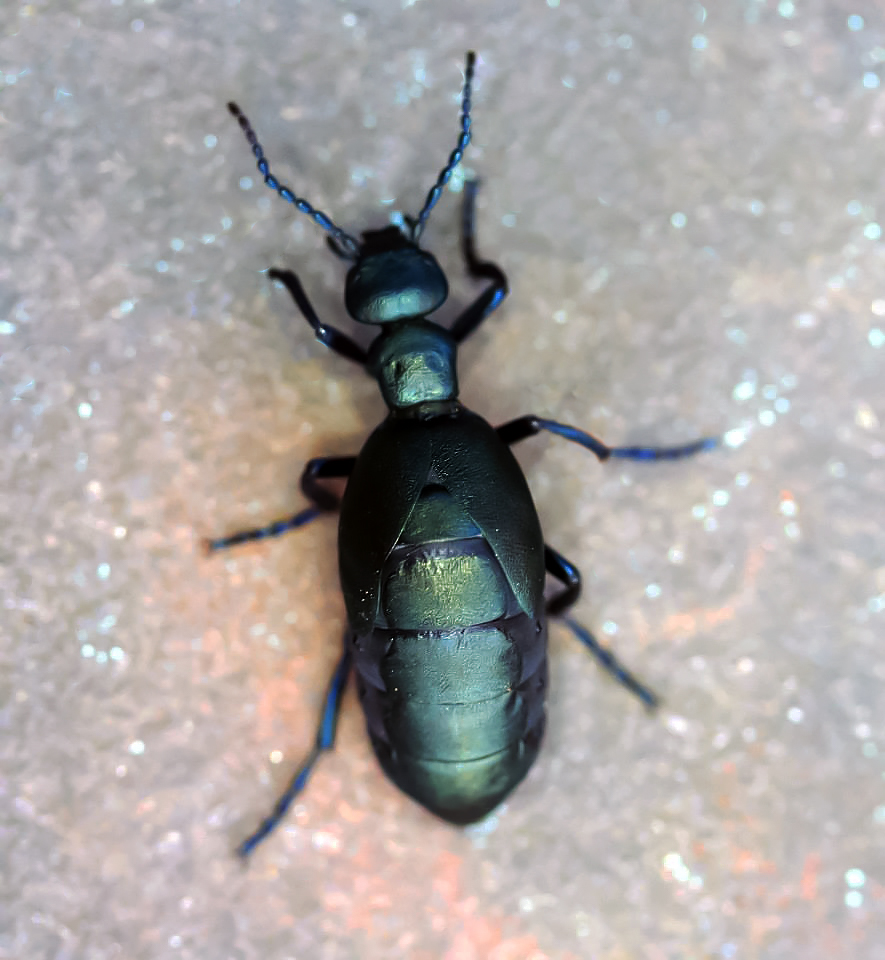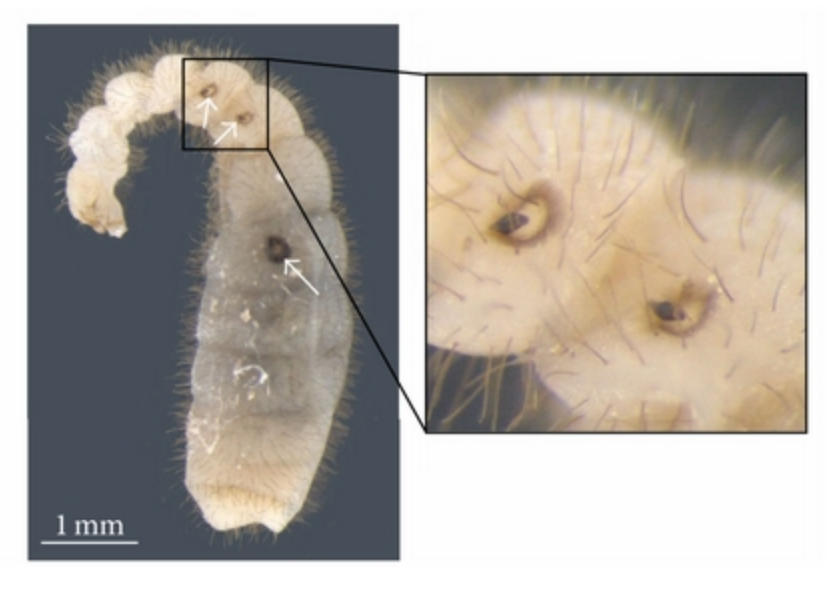|
Triungulin
A planidium is a specialized form of insect larva seen in the first-instar of a few families of insects that have parasitoidal ways of life. They are usually flattened, highly sclerotized (hardened), and quite mobile. The function of the planidial stage is to find a host on which the later larval instars may feed, generally until the insect pupates. Etymology The term "planidium" is derived from the Greek language ''πλανής'' (planis) meaning "wanderer". The term planula was similarly derived in reference to the wandering larvae of certain Cnidaria. Accordingly, "planidium" is the general term for such an adaptation, and it is not limited to any particular species or morphology. Planidia of different species differ variously from each other in form. The first instar larva in the beetle family Meloidae has three claws on each foot, and is therefore called a triungulin (plural ''triungula''). The term is derived from the Latin ''tri'' meaning "three" and ''ungula'' meaning ... [...More Info...] [...Related Items...] OR: [Wikipedia] [Google] [Baidu] |
Hypermetamorphosis2
Hypermetamorphosis, or heteromorphosis,P.J. Gullan & P.S. Cranston. 2010. The Insects: An Outline of Entomology, 4th Edition. Wiley-Blackwell. is a term used in entomology that refers to a class of variants of holometabolism, that is to say, complete insect metamorphosis, but where some larval instars are distinct from each other. Description Hypermetamorphosis, as the term normally is used in entomology, refers to a class of variants of holometabolism. In hypermetamorphosis some larval instars are functionally and morphologically distinct from each other. The general case in holometabolous insects such as flies, moths, or wasps, is that all larval stages look similar, growing larger as the insect matures. In hypermetamorphic insects however, at least one instar, usually the first, differs markedly from the rest. In many hypermetamorphic species, the first instars are numerous, tiny, very mobile larvae that must find their way to a food source. The general term for a mob ... [...More Info...] [...Related Items...] OR: [Wikipedia] [Google] [Baidu] |
Meloe
The blister beetle genus ''Meloe'' is a large, widespread group commonly referred to as oil beetles. They are known as "oil beetles" because they release oily droplets of hemolymph from their joints when disturbed; this contains cantharidin, a poisonous chemical causing blistering of the skin and painful swelling. Members of this genus are typically flightless, without functional wings, and shortened elytra. As in other members of the family, they are hypermetamorphic, going through several larval stages, the first of which is typically a mobile triungulin that finds and attaches to a host in order to gain access to the host's offspring. In this genus, the host is a bee Bees are winged insects closely related to wasps and ants, known for their roles in pollination and, in the case of the best-known bee species, the western honey bee, for producing honey. Bees are a monophyletic lineage within the superfamil ..., and each species of ''Meloe'' may attack only a single spec ... [...More Info...] [...Related Items...] OR: [Wikipedia] [Google] [Baidu] |
Acrididae
The AcrididaeMacLeay WS (1821) ''Horae Entomologicae or Essays on the Annulose Animals'' 2 are the predominant family of grasshoppers, comprising some 10,000 of the 11,000 species of the entire suborder Caelifera. The Acrididae are best known because all locusts (swarming grasshoppers) are of the Acrididae. The subfamily Oedipodinae is sometimes classified as a distinct family Oedipodidae in the superfamily Acridoidea. Acrididae grasshoppers are characterized by relatively short and stout antennae, and tympanal organ, tympana on the side of the first abdominal segment. Subfamilies The ''Orthoptera Species File'' (September 2021) lists the following subfamilies of Acrididae. The numbers of genera and species are approximate and may change over time. # Acridinae MacLeay, 1821 (140 genera, 470 species), Worldwide: temperate and tropical # Calliptaminae Jacobson, 1905 (12 genera, 90 species), Africa, Europe, Asia # Caryandinae Yin & Liu, 1987 (3 genera, 100 species), Afric ... [...More Info...] [...Related Items...] OR: [Wikipedia] [Google] [Baidu] |
Phoresy
Phoresis or phoresy is a non-permanent, commensalistic interaction in which one organism (a phoront or phoretic) attaches itself to another (the host) solely for the purpose of travel. Phoresis has been observed directly in ticks and mites since the 18th century, and indirectly in fossils 320 million years old. It is not restricted to arthropods or animals; plants with seeds that disperse by attaching themselves to animals are also considered to be phoretic. ''Phoresis'' is rooted in the Greek words ''phoras'' (bearing) and ''phor'' (thief). The term, originally defined in 1896 as a relationship in which the host acts as a vehicle for its passenger, clashed with other terminology being developed at the time, so constraints on the length of time, feeding and ontogeny are now considered. Phoresis is used as a strategy for dispersal, seasonal migration, transport to new host/habitat escaping ephemeral habitats, and reducing inbreeding depression. In addition to the benefi ... [...More Info...] [...Related Items...] OR: [Wikipedia] [Google] [Baidu] |
Perilampidae
The Perilampidae are a small family within the Chalcidoidea, composed mostly of hyperparasitoids. The family is closely related to the Eucharitidae, and the eucharitids appear to have evolved from within the Perilampidae, thus rendering the family paraphyletic (if the two families are joined in the future, the name with precedence is Eucharitidae). As presently defined, at least 15 genera and 270 species are described worldwide. They are often brilliantly metallic (especially blue or green), with robust mesosomae and a small, triangular metasomae (swollen and bulbous in the Philomidinae). They are generally very strongly sculptured. The prothorax is typically very broad and disc-like, and the labrum is multidigitate, a feature shared with the Eucharitidae. Another feature shared by the Eucharitidae and Perilampidae is the first-instar larvae are called " planidia" and are responsible for gaining access to the host, rather than the egg-laying females. Those species which are ... [...More Info...] [...Related Items...] OR: [Wikipedia] [Google] [Baidu] |
Eucharitidae
The Eucharitidae are a family of parasitic wasps.Ayre, G.L. Pseudometagea schwarzii (Ashm.) (Eucharitidae: Hymenoptera), a parasite of Lasius neoniger Emery (Formicidae: Hymenoptera). Canadian Journal of Zoology 40 (1962) : 157-164. Eucharitid wasps are members of the superfamily Chalcidoidea and consist of three subfamilies: Oraseminae, Eucharitinae, and Gollumiellinae. Most of the 55 genera and 417 species of Eucharitidae are members of the subfamilies Oraseminae and Eucharitinae,Heraty, John. Eucharitidae. Hymenopteran Systematics, University of California, Riverside (2002): Web. 16 Sep. 2011. and are found in tropical regions of the world. Eucharitids are specialized parasitoids of ants, meaning each species is usually only parasitic of one genus of ant. Furthermore, they are one of the few parasitoids that have been able to use ants as hosts, despite ants’ effective defense systems against most parasitoids.Lachaud, Jean-Paul and Perez-Lachaud, Gavriela. Impact of na ... [...More Info...] [...Related Items...] OR: [Wikipedia] [Google] [Baidu] |
Parasitic Wasp
Parasitoid wasps are a large group of hymenopteran superfamilies, with all but the wood wasps ( Orussoidea) being in the wasp-waisted Apocrita. As parasitoids, they lay their eggs on or in the bodies of other arthropods, sooner or later causing the death of these hosts. Different species specialise in hosts from different insect orders, most often Lepidoptera, though some select beetles, flies, or bugs; the spider wasps (Pompilidae) exclusively attack spiders. Parasitoid wasp species differ in which host life-stage they attack: eggs, larvae, pupae, or adults. They mainly follow one of two major strategies within parasitism: either they are endoparasitic, developing inside the host, and koinobiont, allowing the host to continue to feed, develop, and moult; or they are ectoparasitic, developing outside the host, and idiobiont, paralysing the host immediately. Some endoparasitic wasps of the superfamily Ichneumonoidea have a mutualistic relationship with polydnaviruses, th ... [...More Info...] [...Related Items...] OR: [Wikipedia] [Google] [Baidu] |
Tachinidae
The Tachinidae are a large and variable family of true flies within the insect order Diptera, with more than 8,200 known species and many more to be discovered. Over 1,300 species have been described in North America alone. Insects in this family commonly are called tachinid flies or simply tachinids. As far as is known, they all are protelean parasitoids, or occasionally parasites, of arthropods, usually other insects. The family is known from many habitats in all zoogeographical regions and is especially diverse in South America. Life cycle Reproductive strategies vary greatly between Tachinid species, largely, but not always clearly, according to their respective life cycles. This means that they tend to be generalists rather than specialists. Comparatively few are restricted to a single host species, so there is little tendency towards the close co-evolution one finds in the adaptations of many specialist species to their hosts, such as are typical of protelean paras ... [...More Info...] [...Related Items...] OR: [Wikipedia] [Google] [Baidu] |
Nemestrinidae
Nemestrinidae, or tangle-veined flies is a family of flies in the superfamily Nemestrinoidea, closely related to Acroceridae. The family is small but distributed worldwide, with about 300 species in 34 genera. Larvae are endoparasitoids of either grasshoppers (Trichopsideinae) or scarab beetles (Hirmoneurinae). Some are considered important in the control of grasshopper populations. Adults are often observed on flowers. Genera * '' Atriadops'' * '' Ceyloniola'' * '' Cyclopsidea'' * '' Fallenia'' * '' Hirmoneura'' * '' Hyrmophlaeba'' Rondani, 1864 * '' Moegistorhynchus'' * '' Nemestrinus'' * '' Neohirmoneura'' * '' Neorhynchocephalus'' Lichtwardt, 1909 * '' Nycterimorpha'' * '' Nycterimyia'' * '' Prosoeca'' * '' Stenobasipteron'' * '' Stenopteromyia'' * '' Trichophthalma'' * '' Trichopsidea'' Westwood, 1839 Data sources: i = ITIS, c = Catalogue of Life, g = GBIF, b = Bugguide.net Fossil history Fossils of Nemestrinidae are known from several localities of various ages in Russi ... [...More Info...] [...Related Items...] OR: [Wikipedia] [Google] [Baidu] |
Bombyliidae
The Bombyliidae are a family of flies, commonly known as bee flies. Adults generally feed on nectar and pollen, some being important pollinators. Larvae are mostly parasitoids of other insects. Overview The Bombyliidae are a large family of flies comprising hundreds of genera, but the life cycles of most species are known poorly, or not at all. They range in size from very small (2 mm in length) to very large for flies (wingspan of some 40 mm).Hull, Frank Montgomery, Bee flies of the world: the genera of the family Bombyliidae Washington, Smithsonian Institution Press 1973 . Downloadable from: https://archive.org/details/beefliesofworl2861973hull When at rest, many species hold their wings at a characteristic "swept back" angle. Adults generally feed on nectar and pollen, some being important pollinators, often with spectacularly long proboscises adapted to plants such as '' Lapeirousia'' species with very long, narrow floral tubes. Unlike butterflies, bee flies ... [...More Info...] [...Related Items...] OR: [Wikipedia] [Google] [Baidu] |
Acroceridae
The Acroceridae are a small family of odd-looking flies. They have a hump-backed appearance with a strikingly small head, generally with a long proboscis for accessing nectar. They are rare and not widely known. The most frequently applied common names are small-headed flies or hunch-back flies. Many are bee or wasp mimics. Because they are parasitoids of spiders, they also are sometimes known as spider flies. Description The Acroceridae vary in size from small to fairly large, about the size of large bees, with a wingspan over 25 mm in some species. As a rule, both sexes have tiny heads and a characteristic hump-backed appearance because of the large, rounded thorax. In appearance, they are compact flies without major bristles, but many species have a bee-like hairiness on their bodies, and some are bee or wasp mimics. In most species, the eyes are holoptic in both sexes, the heads seemingly composed mainly of the large faceted eyes. This is in contrast to many insects in ... [...More Info...] [...Related Items...] OR: [Wikipedia] [Google] [Baidu] |




_(7686081848).jpg)


